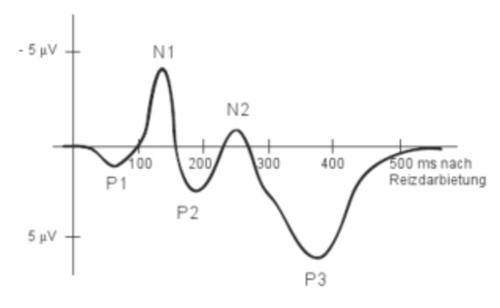Elektroencephalography (EEG)
The EEG is a relatively old technique (first use in 1924 by Hans Berger) and a well established method to make brain activity visible. In contrast to imaging techniques that show metabolic changes, the EEG records mainly the activity of the nerve cells themselves.
Technology
To record the EEG electrodes are positioned on the scalp while electrode paste makes contact to the head surface. The weak electrical signal is converted and enhanced by an analog / digital (A / D) converter from analogue continuous signal into a digital time-discrete signal and transmitted to the computer for storage.
There is a distinction between wake- and sleep-EEG, and rest- and activity-EEG.The basic activity in the brain is characterized by the alternation of positive and negative potentials. The basic activity is correlated with processes of awareness and concentration. Five basic EEG frequency bands are distinguished: alpha (8-12Hz), beta (14-40Hz), theta (4-7Hz), delta (1-4Hz) and gamma (40Hz).
Besides the basic activity in the frequency range, information processing is examined in the time domain by using event-related potentials (ERPs). For this purpose the EEG activity is measured in response to the presentation of external stimuli. This activity reflects - according to research design - basal information processing, motor responses, or higher cognitive and emotional processes. Because of the higher amplitude of the basic brain activity ERPs must be filtered out from this activity. The filtering is done by averaging over a series of identical stimuli.
The continuous EEG measurement with high temporal resolution allows for a connection between cognitive processes and emotional processing and brain activity. The EEG reflects always the activity of many nerve cell assemblies, thus due to the distance between the electrodes and the cells, the spatial resolution is much lower than in imaging techniques.
ERP Components
The ERP is a sequence of positive and negative voltage changes over time. Components are determined by Donchin, Ritter, and McCallum (1978) for the following criteria:
Polarity involves a shift of the voltage relative to the base and a reference activation.
Latency indicates the peak value of the amplitude in temporal relation to the presentation of a stimulus.
Topography represents the position on the head surface and identifies the active brain region.
Sensitivity describes the relationship of the measured activity with the experimental manipulation.
Laboratories
The D.I.N.E. hosts five EEG labs. There are 8 cascadable 32 channel brainAmp amplifiers (Brainproducts), plus one single 64 channel EEG amplifier (TMS).
